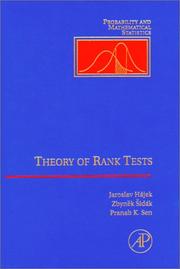| Listing 1 - 7 of 7 |
Sort by
|
Book
Abstract | Keywords | Export | Availability | Bookmark
 Loading...
Loading...Choose an application
- Reference Manager
- EndNote
- RefWorks (Direct export to RefWorks)
Book
Abstract | Keywords | Export | Availability | Bookmark
 Loading...
Loading...Choose an application
- Reference Manager
- EndNote
- RefWorks (Direct export to RefWorks)
Book
Abstract | Keywords | Export | Availability | Bookmark
 Loading...
Loading...Choose an application
- Reference Manager
- EndNote
- RefWorks (Direct export to RefWorks)
Book
Abstract | Keywords | Export | Availability | Bookmark
 Loading...
Loading...Choose an application
- Reference Manager
- EndNote
- RefWorks (Direct export to RefWorks)
Book
Year: 1967 Publisher: New York, NY : Prague : Academia Publishing House of the Czechoslovak Academy of Sciences, Academic Press ;
Abstract | Keywords | Export | Availability | Bookmark
 Loading...
Loading...Choose an application
- Reference Manager
- EndNote
- RefWorks (Direct export to RefWorks)
Mathematical statistics --- Statistique mathématique --- Statistique

ISBN: 1281145033 9786611145033 0080519105 0585492298 9780585492292 9780126423501 0126423504 Year: 1999 Publisher: San Diego, Calif. : Academic Press,
Abstract | Keywords | Export | Availability | Bookmark
 Loading...
Loading...Choose an application
- Reference Manager
- EndNote
- RefWorks (Direct export to RefWorks)
The first edition of Theory of Rank Tests (1967) has been the precursor to a unified and theoretically motivated treatise of the basic theory of tests based on ranks of the sample observations. For more than 25 years, it helped raise a generation of statisticians in cultivating their theoretical research in this fertile area, as well as in using these tools in their application oriented research. The present edition not only aims to revive this classical text by updating the findings but also by incorporating several other important areas which were either not properly developed before
Ranking and selection (Statistics) --- Statistical hypothesis testing. --- Hypothesis testing (Statistics) --- Significance testing (Statistics) --- Statistical significance testing --- Testing statistical hypotheses --- Selection and ranking (Statistics) --- Distribution (Probability theory) --- Hypothesis --- Mathematical statistics --- Order statistics --- 519.244 --- 519.244 Sequential methods. Optimal stopping. Cusum technique (cumulative sum technique) --- Sequential methods. Optimal stopping. Cusum technique (cumulative sum technique) --- Rang et sélection (Statistique) --- Tests d'hypothèses (Statistique) --- ELSEVIER-B EPUB-LIV-FT

ISBN: 0126423504 0585492298 9780585492292 9780126423501 Year: 1999 Publisher: San Diego Academic Press
Abstract | Keywords | Export | Availability | Bookmark
 Loading...
Loading...Choose an application
- Reference Manager
- EndNote
- RefWorks (Direct export to RefWorks)
The first edition of Theory of Rank Tests (1967) has been the precursor to a unified and theoretically motivated treatise of the basic theory of tests based on ranks of the sample observations. For more than 25 years, it helped raise a generation of statisticians in cultivating their theoretical research in this fertile area, as well as in using these tools in their application oriented research. The present edition not only aims to revive this classical text by updating the findings but also by incorporating several other important areas which were either not properly developed before 1965 or have gone through an evolutionary development during the past 30 years. This edition therefore aims to fulfill the needs of academic as well as professional statisticians who want to pursue nonparametrics in their academic projects, consultation, and applied research works. Key Features * Asymptotic Methods * Nonparametrics * Convergence of Probability Measures * Statistical Inference.
| Listing 1 - 7 of 7 |
Sort by
|

 Search
Search Feedback
Feedback About UniCat
About UniCat  Help
Help News
News